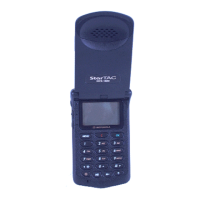6/29/98 27
Testing and Adjustments
Step 7.
With all necessary adjustments
made and power step “0B”
showing in the display, depress
]
to store all updated data and exit
the
73#
command.
Step 8.
After adjusting the TX output
power, check the TX current. The
TX current should be within 450 to
650 mA at power step 2 on all
channels. (Check Low, Mid, and
High channel.) Enter the following
commands:
11039#
to place the
telephone on
channel 039
122
# to select power
step 2
05#
transmitter On
46#061001#
Shuts the display
and backlight off.
Check the TX current drain.
Repeat this procedure on channels
434 and 816 to verify that the TX
current drain does not exceed
600mA. The board is defective if the
current drain exceeds 650 mA when
power step 2 is properly adjusted to
28 dBm.
46#061010#
Turns the display
and backlight on.
Maximum Deviation Adjust
Step 9. Inject an unbalanced 1kHz 2.24V
rms audio signal at J3 pin 6 (TX
audio in). Connect the audio
generator ground lead to J3 pin 15
(audio ground).
The audio signal source must be
low impedance or the injection
signal must be measured at pin 10
to ensure the proper level of 2.24 V
rms.
Step 10. Enter the following commands:
58# to enable compandor
10# to unmute TX audio
356# to select external audio
path
11039# to place the telephone on
channel 039
125# to select power step 5
Step 11. Enter 72#. step 00 will be displayed
on the left side of the display.
Step 12. Read the peak deviation on the
analyzer.
If it is not in the range of 11 to 12
kHz (preferably closer to 12kHz),
use the volume control or enter
numbers from 00 to 07 via the
keypad to adjust the maximum
deviation as close to 12 kHz as
possible without exceeding 12 kHz.
NOTE
In order to enter hex digits A thru F,
depress the SND button followed by:
0hex A
1hex B
2hex C
3hex D
4hex E
5hex F
NOTE
Before SAT, DSAT, DTMF, data, or micro-
phone deviations can be adjusted, the
maximum deviation must be checked
(and adjusted, if necessary). Proceed as
follows.

